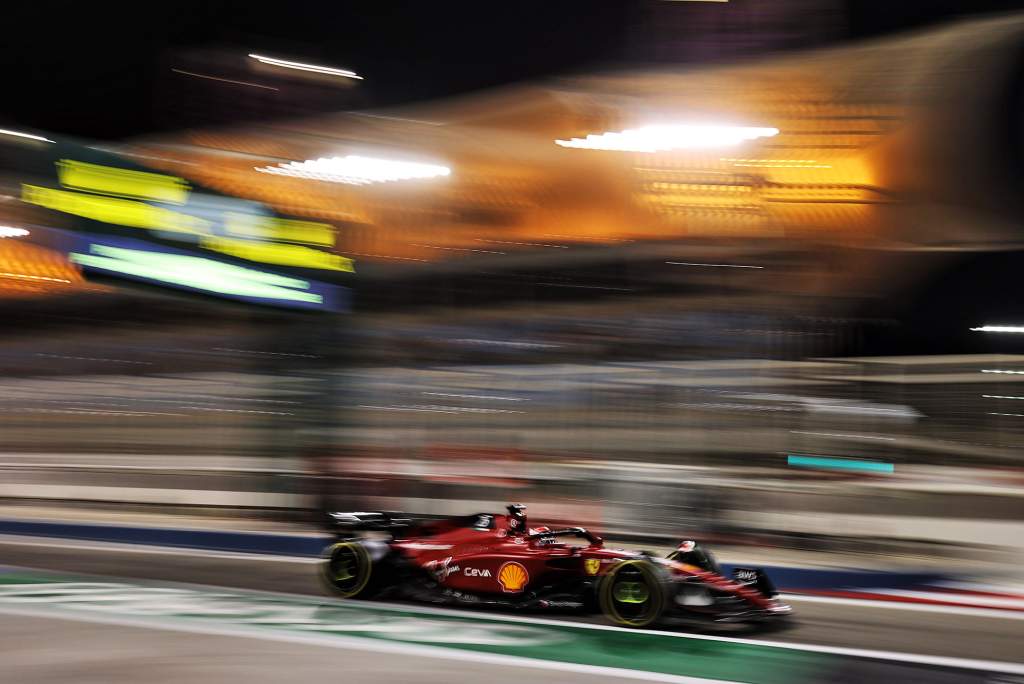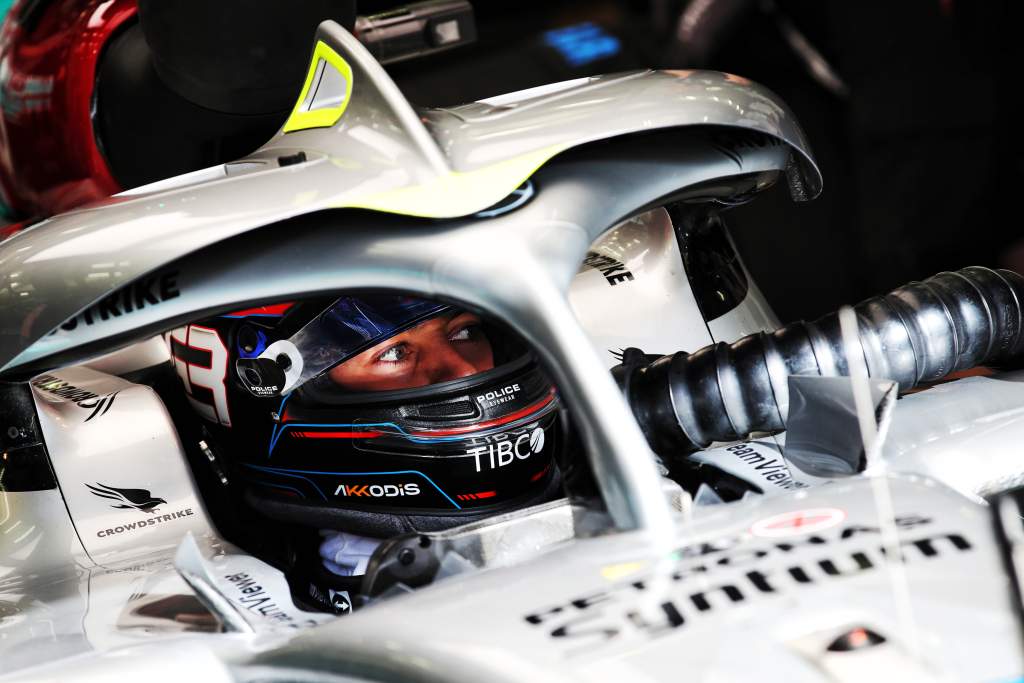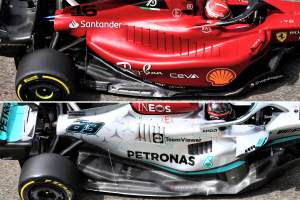Mark Hughes: Red Bull usurps Ferrari as Mercedes trails
Red Bull’s final-day Formula 1 testing upgrade moved it ahead of Ferrari as the team looking strongest. Mercedes is not currently in their league. More on that and the rest of Mark Hughes’ in-depth analysis of the Saturday times

When the Red Bull with its reshaped sidepods appeared from behind the screens on the final day of 2022 Formula 1 pre-season testing and Sergio Perez drove it down the pitlane, it was the prelude to the F1 goalposts being moved.
His first flying lap in the updated RB18 immediately took him to the top of the timesheets and that form was underwritten with even more certainty when Max Verstappen took over the car in the second part of the test.
Red Bull has usurped Ferrari as the star of winter testing. Mercedes at the moment lags behind them both.
The list of headline times is even more meaningless than usual for pre-season testing. But there are some very significant laps which begin to build a picture.
DAY THREE TIMES
1. Verstappen (Red Bull) 1m31.720s, C5
2. Leclerc (Ferrari) 1m32.415s, C4
3. Alonso (Alpine) 1m32.698s, C4
4. Russell (Mercedes) 1m32.759s, C5
5. Bottas (Alfa Romeo) 1m32.985s, C3
6. Tsunoda (AlphaTauri) 1m33.002s, C5
7. Perez (Red Bull) 1m33.105s, C4
8. Schumacher (Haas) 1m33.151s, C3**
9. Norris (McLaren) 1m33.191s, C3
10. Vettel (Aston Martin) 1m33.821s, C4
11. Zhou (Alfa Romeo) 1m33.959s, C4*
12. Gasly (AlphaTauri) 1m34.865s, C4*
13. Sainz (Ferrari) 1m34.905s, C5*
14. Albon (Williams) 1m35.171s, C3
15. Latifi (Williams) 1m35.634s, C3
16. Stroll (Aston Martin) 1m36.029s, C3*
17. Hamilton (Mercedes) 1m36.217s, C5*
18. Magnussen (Haas) 1m38.616s, C2*
* Set in the first session
** Schumacher later did a 1m32.241s on C4 tyres in Haas’s extra two hours of solo running
The first of them is Valtteri Bottas’ time late in the day on a C3 tyre which was only 1.265s off Verstappen’s fastest time of the day on a tyre supposedly around 1s slower. Which would imply that the Alfa Romeo is only 0.265s slower than the Red Bull – which is highly unlikely. That adjusts for tyres but – crucially – not fuel loads.
When we take a look at the stint simulations, it would appear the Alfa Romeo is more like 1.5s adrift of a Red Bull or Ferrari pace. Which in turn implies that if there was just a qualifying level of fuel in the Alfa Romeo when Bottas set that fifth-fastest time of the day, then the Red Bull must have been carrying 1.235s-worth (1.5s minus 0.265s) when Verstappen set his 1m31.72s.
The Sakhir circuit is quite punishing of fuel weight at around 0.35s for every 10kg. So if the Red Bull was carrying 1.235s-worth of fuel more than the Alfa Romeo, that would equate to around 35kg. Which is a very typical testing base fuel weight for the top teams.
So on low fuel qualifying spec we could expect the Red Bull to be capable of lapping in around 1m30.5s on that C5 tyre. But on the C3 – the softest available for next week’s race – the equivalent would be around 1m31.5s.

Forget Mercedes for a moment and let’s just look at Red Bull relative to Ferrari. Is the RB18 really 0.7s faster than the F1-75? Probably not. For one thing Charles Leclerc’s best time was set before the red flag for Bottas’ broken-down car, whereas Verstappen’s was set afterwards at a time of day when the cooling track is becoming ever-faster. There was probably 15 minutes between the setting of those two times.
Secondly, after setting his time, Leclerc came in for another new set of tyres and attempted to better it. He was almost 0.3s faster through the middle sector, but lost just over that through sectors 1 and 3. His best lap was potentially 0.3s better than his headline time.
That would still have left him 0.4s shy of Verstappen’s later time, but some of that deficit was probably accounted for by the difference in track grip.
Post red-flag, as Verstappen got into the high 1m31s (he preceded his 1m31.7s with a 1m31.9s), Leclerc was into a long run. It was a very impressive 12-lap run on the C3 tyre which averaged 1m38.44s. Prior to the red flag (at about the time Leclerc was doing his single lap runs) Verstappen did a nine-lap run on the same C3 tyre and averaged 1m38.27s. But in this case the comparison probably flatters Leclerc because of the same variance in track grip in the cooling evening.
On this evidence the Red Bull has a small but significant advantage over the Ferrari. It’s as if Red Bull has been a couple of weeks behind Ferrari in its programme and has taken that much longer to extract the most from it.
The way Ferrari ran its test programme both at Barcelona and here, the clockwork running through of its programmes, suggests it was extremely well prepared and that the car is very good relative to most of the opposition. But Red Bull, typically, had a late but very fruitful development.

At the time of writing Mercedes is not in any shape to compete with either of these teams. The porpoising of the W13 is still extreme and even if we assume the same power unit usage as we outlined here yesterday, that’s nowhere near enough to account for the shortfall of 1s in single lap pace.
Here’s how George Russell summarised it.
“It’s pretty clear the problems teams were facing with the bouncing and we’re just trying to get on top of that…
“It depends how hard you push the car. I was just trying to push those limits – but it’s not the comfiest.
“I don’t really care about that if the performance is there but at the moment the performance isn’t really there.
“We do seem a step behind our rivals. We do have a lot of work to do between now and next week because in every condition the Red Bull and Ferrari do seem a step ahead of us.
“I don’t think they are exceptional – it’s more that we aren’t as competitive as we’d like. The Ferrari and Red Bull are in their natural position. Their delta to the midfield is probably correct – we’re a little bit behind.
“I believe the guys will get to the bottom of it. We just need to find a way to unlock the performance.
“It’s pretty clear where we’re limited. You just need to look at the onboards to see that. We’ve yet to find a solution to this but that doesn’t mean we won’t find one ahead of next week.
“This is a long game. The performance is there somewhere, we just have to find it. We optimised the performance more in Barcelona than here but the fundamental issues are the same.”
Lewis Hamilton conducted the first session running for the team, experimenting with set-ups before putting together two stints on the C2 tyre of 18 and 14 laps. These appeared to be simulations of first and second race stints with the appropriate fuel loads. They cannot be compared to the long runs done by others in the evening sessions when the track was so much faster.
Russell didn’t do a long run then as the team continued to grapple with the aerodynamic misbehaviour. Here’s how Hamilton’s runs compared to others doing similar programmes at the same time. They are probably a reasonable representation of where Mercedes actually is.
Opening session 1st stint simulation
Sainz 10 laps C3 1m40.846s average
Norris 10 laps C2 1m41.213s
Hamilton 18 laps C2 1m41.341s
Gasly 17 laps C3 1m42.700s
Zhou 27 laps C2 1m42.921s
Latifi 14 laps C2 1m43.811
Opening session 2nd stint simulation
Hamilton 14 laps C2 1m39.814s
Magnussen 14 laps C2 1m40.184s
Alonso 15 laps C2 1m40.242s
Gasly 25 laps C2 1m41.685s
Zhou 13 laps C2 1m42.630s
Latifi 20 laps C2 1m42.762s
Looking at the comparison with Carlos Sainz in the first stint, the headline number flatters the Ferrari because of the shorter stint on the softer tyre. But not by enough to put the Mercedes ahead.
As for the second session long runs, there was a wide divergence of apparent programmes and we can only take an educated guess at what the stint representations were – as no one did an actual race simulation. Below are the averages in the context of suggested stint simulations.
Later session 1st stint
Schumacher 14 laps C2 1m42.131s
Later session 2nd stint
Alonso 9 laps C3 1m40.584s
Vettel 9 laps C3 1m40.636s
Alonso 15 laps C2 1m40.762s
Bottas 10 laps C2 1m41.303s
Latifi 23 laps C2 1m41.359s
Later session 3rd stint
Verstappen 9 laps C3 1m38.270s
Leclerc 12 laps C3 1m38.439s
Alonso 12 laps C2 1m39.423s
Bottas 20 laps C2 1m40.761s
So from these various long runs we might deduce the Red Bull is faster than the Ferrari which in turns is faster than the Mercedes which may – or may not – be faster than the McLaren. But the McLaren didn’t do many long runs.
The Haas is slower than the Mercedes (and by extension the McLaren) but would appear to be slightly faster than the Alpine which is faster than the Aston Martin and the AlphaTauri which in turn is faster than the Alfa Romeo which edges out the Williams!
A lot of assumptions in there, but that’s the best we got…




